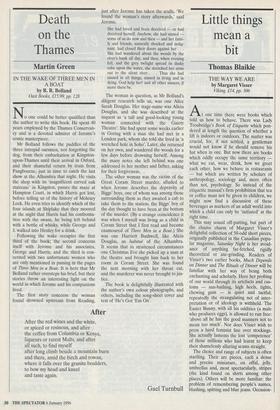Death on the Thames
Martin Green
IN THE WAKE OF THREE MEN IN A BOAT by R. R. Bolland Oast Books, £15.99, pp. 128 No one could be better qualified than the author to write this book. He spent 40 years employed by the Thames Conservan- cy and is a devoted admirer of Jerome's comic masterpiece.
Mr Bolland follows the paddles of the three intrepid oarsmen, not forgetting the dog, from their embarkation at Kingston- upon-Thames until their arrival in Oxford, and their shameful return by train from Pangbourne, just in time to catch the last show at the Alhambra that night. He visits the shop with its 'magnificent carved oak staircase' in Kingston, passes the maze at Hampton Court, in which Harris got lost, before telling us of the history of Molesey Lock. He even tries to identify which of the four islands at Shiplake that they moored at the night that Harris had his confronta- tion with the swans, he being left behind with a bottle of whisky, while George and J. walked into Henley for a drink.
Following the wake occupies the first third of the book; the second concerns itself with Jerome and his associates, George and Harris; and the third is con- cerned with two unfortunate women who are only mentioned in passing in the pages of Three Men in a Boat. It is here that Mr Bolland rather oversteps his brief, but their stories throw an interesting light on the world in which Jerome and his companions lived.
The first story concerns the woman found drowned upstream from Reading, just after Jerome has taken the sculls. 'We found the woman's story afterwards,' said Jerome.
She had loved and been deceived — or had deceived herself. Anyhow, she had sinned some of us do now and then — and her fami- ly and friends, naturally shocked and indig- nant, had closed their doors against her . . . She had wandered about the woods by the river's bank all day, and then, when evening fell, and the grey twilight spread its dusky robe upon the water, she stretched her arms out to the silent river . . . Thus she had sinned in all things, sinned in living and in dying. God help her! and all other sinners, if more there be.
The woman in question, as Mr Bolland's diligent research tells us, was one Alice Sarah Douglas. Her stage-name was Alicia Douglas, and she was described at the inquest as 'a tall and good-looking young woman connected with the Gaiety Theatre'. She had spent some weeks earlier in Goring with a man she had met in a London park, whom she told she lived in 'a wretched hole in Soho'. Later, she returned on her own, and wandered the woods for a few days before drowning herself. Among the many notes she left behind was one addressed to her mother and father, asking for their forgiveness.
The other woman was the victim of the Great Coram Street murder, alluded to when Jerome describes the depravity of Biggs' boys, one of whom was among those surrounding them as they awaited a cab to take them to the station; the Biggs' boy of the day thought to have been at the bottom of the murder. (By a strange coincidence it was when I myself was living as a child in Coram Street that I first read and became enamoured of Three Men in a Boat.) She was one Harriett Bushwell, like Alicia Douglas, an habitué of the Alhambra. It seems that in straitened circumstances one Christmas Eve she picked up a man at the theatre and brought him back to her room in Coram Street. She was found the next morning with her throat cut, and the murderer was never brought to jus- tice.
The book is delightfully illustrated with the author's own colour photographs, and others, including the song-sheet cover and text of 'He's Got 'Em On'.


















































 Previous page
Previous page